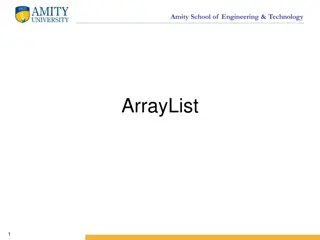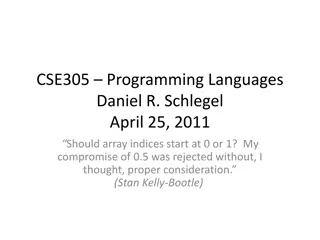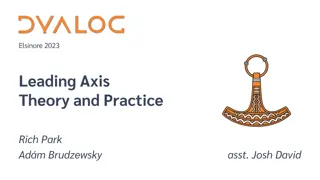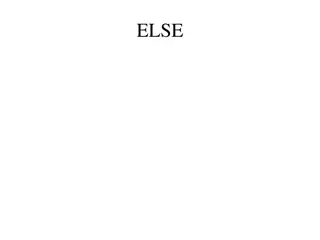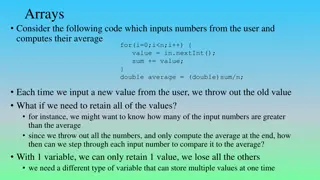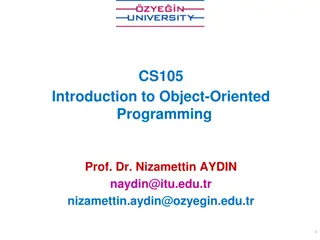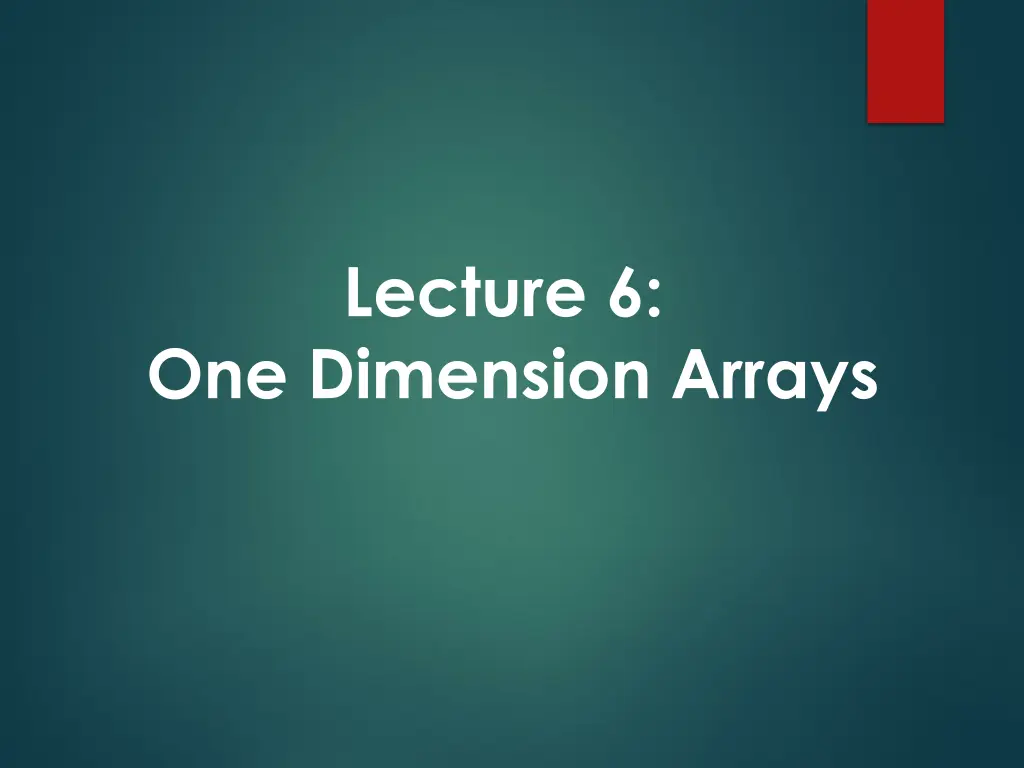
Understanding One-Dimensional Arrays in Programming
Explore the concept of one-dimensional arrays, including defining arrays, initializing array contents, processing array elements, and more. Learn how to access array elements and work with array subscripts effectively. Dive into practical examples and exercises to solidify your understanding of arrays.
Download Presentation

Please find below an Image/Link to download the presentation.
The content on the website is provided AS IS for your information and personal use only. It may not be sold, licensed, or shared on other websites without obtaining consent from the author. If you encounter any issues during the download, it is possible that the publisher has removed the file from their server.
You are allowed to download the files provided on this website for personal or commercial use, subject to the condition that they are used lawfully. All files are the property of their respective owners.
The content on the website is provided AS IS for your information and personal use only. It may not be sold, licensed, or shared on other websites without obtaining consent from the author.
E N D
Presentation Transcript
Lecture 6: One Dimension Arrays
Topics 6.1 Array Concept 6.2 Defining Array 6.3 Array Initialization 6.4 Inputting Array Contents 6.5 Processing Array Contents 6.6 Displaying Array Contents 6.7 Notes about Arrays 6.8 In which stage we use Arrays? 6.9 LAB Exercises
6.1 Array Concept Array: a variable that can store multiple values of the same type Values are stored in adjacent memory locations Declared using [] operator int A[5]; This allocates the following memory locations Element 0 Element 1 Element 2 Element 3 Element 4
Accessing Array Elements Array elements (accessed by array name and subscript) can be used as regular variables A 0 1 2 3 4 A[0] = 79; cout << A[0]; cin >> A[1]; //user puts 88 A[4] = A[0] + A[1]; A 79 88 167 0 1 2 3 4
Array Subscripts Array subscript (index) can be an integer constant, integer variable, or integer expression Examples: int A[5]; int i=1; int j=2; cin >> A[2]; int constant cout << A[i]; int variable cout << A[i+j]; int expression
6.2 Defining Array In the definition int A[5]; //holds 5 integer cells int is the data type of the array elements A is the name of the array 5 is the number of elements. It shows the number of elements in the array. Other Example double volumes[10];//holds 10 double cells
6.3 Array Initialization Can be initialized during program execution with assignment statements A[0] = 79; A[1] = 82; // etc. Can be initialized at array definition with an initialization list int A[5] = {79,82,91,77,84};
Partial Array Initialization If array is initialized at definition with fewer values than the size declarator of the array, remaining elements will be set to 0 or NULL int A[5] = {79, 82}; Initial values used in order; cannot skip over elements to initialize noncontiguous range 79 82 0 0 0
Implicit Array Sizing Can determine array size by the size of the initialization list short quizzes[]={12, 17, 15, 11}; 12 17 15 11 Must use either array size declarator or initialization list when array is defined
6.4 Inputting Array Contents cin can be used to input values from keyboard and store these values into an array element int A[5]; // Define 5-cells array cout << "Enter first number "; cin >> A[0];
Inputting All Array Elements To access each element of an array Use a loop Let the loop control variable be the array subscript A different array element will be referenced each time through each cycle of the loop int A[5]; int i; for (i = 0; i < 5; i++) { cout << Enter Some numbers in to the array "; cin >> A[i]; }
6.5 Processing Array Contents Array elements can be treated as ordinary variables of the same type as the array used in arithmetic operations, in relational expressions, etc. Example: if (A[3] >= 10000) interest = A[3] * intRate1; else interest = A[3] * intRate2;
6.6 Displaying Array Contents cout can be used to display value of the value of an array element int A[5]; // Define 5-cells array cout >> A[0]= << A[0] <<endl;
Displaying All Array Elements To display each element of an array Use a loop Let the loop control variable be the array subscript A different array element will be referenced each time through each cycle of the loop int A[5]; for (int i = 0; i < 5; i++) { cout << A [i] << endl; }
Start 1-16
NOTE 3: Strings and string Objects String is a special type of array of characters. It Can be processed using array name Entire string at once, or One element at a time by using a subscript string city; cout << "Enter city name: "; cin >> city; 'S' 'a' 'l' 'e' 'm' city[0] city[1] city[2] city[3] city[4] In order to use string Array in Input and Output we need to include the following file #include <string>
6.7 Notes about Arrays NOTE 1: No Bounds Checking There are no checks in C++ that an array subscript is in range An invalid array subscript can cause program to overwrite other memory locations Example: int num[3]; //composed of =>num[0], num[1], num[2] int i = 4; num[i] = 25;//we don t have num[4] num 25 [0] [1] [2]
NOTE 2: Using Increment and Decrement Operators with Array Elements confuse the element with the subscript When using ++ and --operators, don t A[i]++; // adds 1 to A[i] A[i++]; // increments i, but has // no effect on A
Array Initialization 1-21 int array[10]; // fine, size of array known to be 10 at compile time const int size = 5; //(error=> int size=5;) int array[size]; // error, size not known at compile time int size; // set size at runtime Cin >> size; int* array = new int[size]; However, this 'raw' usage of new is not recommended as you must use delete to recover the allocated memory. delete[] array;
Array Initialization 1-22 #include<iostream> using namespace std; for (int i = 0; i < size; i++) { int main() cout << array[i] << "\t"; { } int size; cin >> size; delete[] array; //important int * array = new int[size]; system("pause"); for (int i = 0; i < size; i++) return 0; { array[i] = i; } }
NOTE 4: : Copying One Array to Another int A1[5]= {1,2,3,4,5}; int A2[5]; Cannot copy with an assignment statement: A2=A1 ; //Not allowed But we can copy with an assignment statement inside a loop: for (int i=0; i < 5; i++) A2[i] = A1[i];
Ex 6 -1: Comparing Two Arrays Write a program to compare the contents of one array to another and show to the user if the arrays are equal or not. //Comparing two arrays #include <iostream> using namespace std; int main() { const int size = 5; //Array size int A[size] = { 1,2,3,4,5 }; int B[size] = { 1,2,3,44,5 }; int i; //index bool areEqual;
areEqual = true; for (i=0; i < size; i++) { if (A[i] != B[i]) { areEqual = false; } } if (areEqual) { cout << "The Arrays are equal.\n"; } else { cout << "The Arrays are not equal.\n"; } system("pause"); return 0; }
Search inside an array 1-26 Write a program to search for an input inserted by user #include<iostream> if (found) using namespace std; { int main() cout << " Element found Successfully" << endl; { const int size = 5; int number; } int array[size] = { 1,2,3,4,5 }; else bool found = false; { cout << "Element not exist" << endl; cout << "search for a number: "; cin >> number; } for (int i = 0; i < size; i++) system("pause"); { if (array[i] == number) return 0; { } found = true; cout << "at index " << i ; break; } }
Ex 6 -2: Finding The largest of Array elements Q\ Write a program to find the largest element in array of integers Hints: Use a loop to examine each element and find the largest element (i.e., one with the largest value) A similar algorithm exists to find the smallest element //Finding The largest of Array elements #include <iostream> using namespace std;
int main() { int largest; int A[10] = { 7,6,5,9,4,11,3,150,20,12 }; int i, n = 10; //index and Array size largest = A[0]; for (i = 1; i < n; i++) { if (A[i] > largest) largest= A[i]; } } cout << Largest= "<< largest<<endl; system("pause"); return 0;
Ex 6 -3 Write a program to find the sum of all elements in a one dimensional integer array of 5 elements. The elements values should be given by the user. //Calculating sum of Array #include <iostream> using namespace std; int main() { //Define Stage int A[5]; int i; //index int n = 5; //Array size int sum=0; //sum accumulation
for (i = 0; i < n; i++) { cout << "A["<<i<<"] = "; cin >> A[i]; } for (i = 0; i < n; i++) { sum = sum + A[i]; } cout << "The sum = "<< sum<<endl; system("pause"); return 0; }
Two Dimensional Array A two-dimensional array can be think of as a table, which will have x number of rows and y number of columns. 1-31 int arr[2][3];
Two Dimensional Array int test[2][3]= { {2, -5, 6},{4, 0, 9} }; int test[2][3]= { {2, -5, 6}, {4, 0, 9} }; 1-32 1 2 0 2 4 -5 0 6 9 0 1
Two Dimensional Array 1-33 for(int i = 0; i < 2; ++i) for(int i = 0; i < 2; ++i) { { for(int j = 0; j < 3; ++j) for(int j = 0; j < 3; ++j) { { cout<< test[i][j] << \t ; cout<<"Enter your number = "; } cin>> test[i][j]; } } }
Multi Dimensional Array 1-34 Int array[2][3][4]; for(int i = 0; i < 2; ++i) { for(int j = 0; j < 3; ++j) { for(int k = 0; k < 4; k++) { cout<<"Enter your number = "; cin>> array [i][j][k]; } } }
Multi Dimensional Array 1-35 Q- create 3 arrays for name, surname and country. Let the user decide the size of them and let him insert the data. After that create a double dimensional array and send all the data in to the double dimentional array.
6.9 LAB Exercises LAB 6-1: Write a program to add two arrays of type double filled by programmer and put the result in a third array. Display the third array. The size of all arrays is 8. LAB 6-2: Write a C++ program to count how many 2s are there in the array of 10 elements. The elements values should be given by the programmer. LAB 6-3: Write a C++ program to find how many times an input number have been repeated inside an array and at which indexes. The elements values is inserted by the user.
1-37 2- create a search, if an element have been found in an array. You may use random number. to find an element in an index. 4- sort an array in from biggest to smallest and vice versa. 5- put two (one dimensional array) elements in to double dimensional array automatically.


